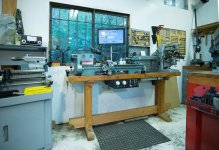MoriMillMan
Aluminum
- Joined
- Jan 6, 2019
Hey guys, I’m making a bench for my lathe. Trying to use up materials I have lying around. I have a couple different options and wanted to see how you folks would use the available materials.
Here’s what I have:







Originally I planned on just putting the top on the legs in second picture and being done. But that’s pretty thin metal and flexes. Thought about reinforcing it with steel too.
The pedestal is nice and heavy. And I think that would help give the small lathe some rigidity.
Maybe pedestal on headstock end and legs on other?
Just wanted to hear some opinions. Thanks.
Here’s what I have:







Originally I planned on just putting the top on the legs in second picture and being done. But that’s pretty thin metal and flexes. Thought about reinforcing it with steel too.
The pedestal is nice and heavy. And I think that would help give the small lathe some rigidity.
Maybe pedestal on headstock end and legs on other?
Just wanted to hear some opinions. Thanks.


